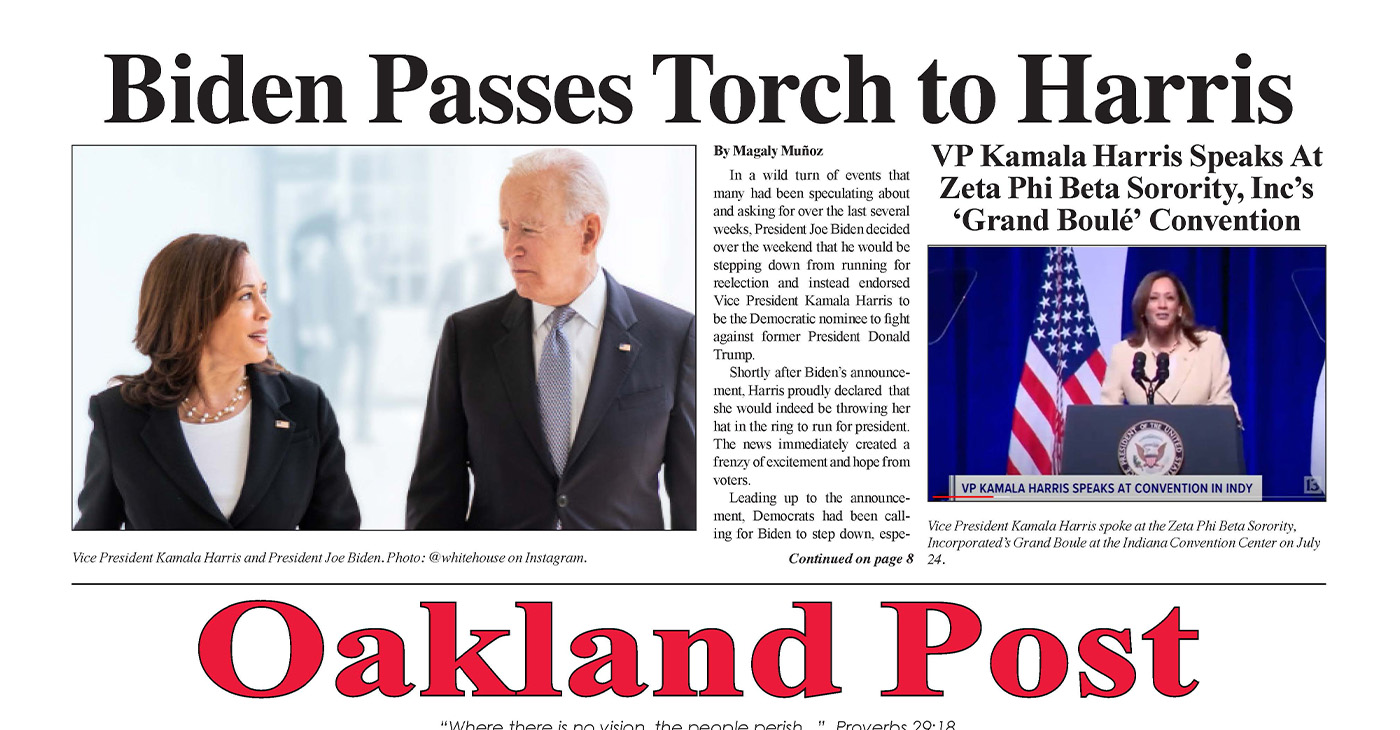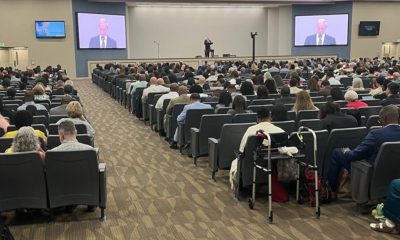Community
Fighting Homelessness: Gov. Newsom Sets Sights on Mental Health, Addiction
“This past year, California has been able to move 58,000 individuals off our streets and into the housing and treatment they desperately needed,” said California Governor Gavin Newsom, adding that it will require a multi-pronged approach to end homelessness because the housing, medical and social needs of unhoused people vary.

By Antonio Ray Harvy, California Black Media
Gov. Gavin Newsom says his administration is emphasizing combating drug addiction and mental illness as part of the state’s multi-year plan to solve California’s homelessness crisis — the worst in the country.
Newsom says focusing on those health needs of unhoused people is a component of his ongoing “Comeback Plan,” an effort launched last year to help the state recover from the economic and social impacts of the pandemic.
“This past year, California has been able to move 58,000 individuals off our streets and into the housing and treatment they desperately needed,” said Newsom, adding that it will require a multi-pronged approach to end homelessness because the housing, medical and social needs of unhoused people vary.
When Newsom presented his budget proposal for Fiscal Year 2022-23 on Jan. 10, he asked the Legislature to approve $12 billion to support his housing strategy. About $3 billion of that amount would be spent on behavioral health housing, creating 44,0000 new housing units and treatment opportunities for people who are mentally ill. Another $2 billion would go to local governments in the form of flexible aid for housing programs, he said.
“The California Blueprint will double down on those efforts, focusing on clearing encampments, while also setting the groundwork for long-term systemic change with significant investments in mental health and substance abuse treatment to get vulnerable people off the streets.”
Black Californians are disproportionately homeless. Of the estimated 160,000 unhoused people in the state, more than 40% are African American.
Newsom said, in addition to several other measures like securing housing for students and veterans, his administration is currently considering a plan to move the state toward conservatorship for people who are mentally ill.
He did not give details about the program, but he said there is a possibility the state will begin entrusting the care of mentally ill people to individuals or institutions in the near future.
In 1967, when Ronald Reagan was governor of California, the State deinstitutionalized mentally ill patients after the Lanterman-Petris-Short Act (LPSA) was passed and signed into law. California was one of the first states to deinstitutionalize mentally ill patients.
The number of mental patients occupying mental hospitals in California reached its highest point at 37,500 in 1959 when former Gov. Jerry Brown’s father, Edmund G. Brown, was governor. It dropped to 22,000 patients eight years later, according to a report by Chauvet Public Relations titled, “The History of Homelessness and Why We Can Do Better.”
Supporters of LPSA believed the law would provide protections for mental health patients and eliminate “the inappropriate, indefinite, and involuntary commitment of persons (to mental institutions) with mental health disorders,” the language of the bill reads.
LSPA critics say it inappropriately empowered mentally ill people to make important health care decisions for themselves when many of them had neither the will nor ability to do so.
When Reagan became president in 1980, he used the Omnibus Budget Reconciliation Act (OBRA) to repeal President Jimmy Carter’s Mental Health Systems Act, which funded federal mental health programs.
The OBRA gave mental patients the authority to make decisions about their treatment, including the options to seek care outside of a mental institution, get treatment at state-run clinics or the freedom to administer their own medication.
Last fall, the Newsom administration publicly let it be known that it is was leading the charge to provide solutions in the areas of low-income housing, mental health, and the state’s enduring homelessness problem.
In October, Newsom vetoed Assembly Bill (AB) 36, authored by Sen. Sydney Kamlager (D-Los Angeles) when she was an assemblymember. The bill would have provided people experiencing homelessness access to health and social services outside the walls of a traditional medical clinic, including mobile clinics and shelter-based and other transitional housing-based health care.
According to Kamlager, AB 36 would have been the first law of its kind in the nation offering unhoused people Medi-Cal benefits without them having to share the cost.
Newsom’s letter explaining the veto says that the unhoused can already receive similar service through California’s Presumptive Eligibility program, which offers Medi-Cal and timely health care.
The bill was endorsed by 70 organizations and leaders across the state, including Los Angeles Mayor Eric Garcetti. In L.A. County, where over 66,000 people are homeless, African Americans make up 34% of that number although the total Black population is nearly 8%.
People of color in California experience some of the highest rates of homelessness in the nation. For example, nationally, 55 Black people experience homelessness out of every 10,000. In California, that number is 194 out of every 10,000.
Pacific Research Institute (PRI) a San-Francisco-based research think tank released a report in April 2021 that specified decreases of homelessness in major metropolitan areas such as New York City and Seattle.
The report, “No Way to End California’s Homelessness Crisis,” says that “Clearly, California is doing something wrong” in terms of finding solutions. Although the state makes up 12% (nearly 40 million residents) of the U.S. population, 27% of all homeless persons live in California, stated Kerry Jackson and Wayne Winegarden, the report’s authors.
According to Jackson and Winegarden, mental illness is one of the driving forces behind the California’s chronic homelessness problem.
But all hope is not lost, the researchers say.
“A new approach is needed. To cut through the state bureaucracy, California should rely on private efforts to minimize homelessness. Private organizations are typically better equipped than the government to make real differences in the lives of the homeless because they tailor programs to meet the specific needs of individual homeless and can adapt where the government cannot.”
Activism
Oakland Post: Week of July 24 – 30, 2024
The printed Weekly Edition of the Oakland Post: Week of July 24 – 30, 2024

To enlarge your view of this issue, use the slider, magnifying glass icon or full page icon in the lower right corner of the browser window. ![]()
#NNPA BlackPress
NNPA NEWSWIRE — Reflecting on his long career, Biden expressed deep gratitude and pride. “Nowhere else on earth could a kid with a stutter from modest beginnings in Scranton and Claymont one day sit behind the Resolute Desk in the Oval Office. But here I am. That’s what makes America special,” he remarked, his voice tinged with emotion.
The post first appeared on BlackPressUSA.

Biden: Our Democracy Demands New Leadership
By Stacy M. Brown, NNPA Newswire Senior Correspondent
@StacyBrownMedia
In an impassioned address from the Oval Office, President Joe Biden laid bare his decision to step down from the 2024 presidential race, urging Americans to embrace a new generation of leadership. “Saving democracy is more important than any title. It’s time to pass the torch to younger voices,” Biden declared in an address that signaled a transformative shift in American politics.
Following his decision over the weekend to bow out of the race for re-election, Biden’s announcement was a clarion call for renewal. Stressing the moment’s urgency, Biden emphasized that the future of democracy depends on fresh, dynamic leadership. He endorsed Vice President Kamala Harris as the embodiment of this new era. “Years ago, I described myself as a transitional candidate, and now it’s time for that transition to take full effect,” Biden said, positioning Harris as the future of the Democratic Party.
While refraining from mentioning former President Donald Trump by name, Biden clarified that he views the twice impeached and 34 times convicted felon Republican presidential nominee as a fundamental threat to democratic values. “My record as president, my leadership on the global stage, and my vision for America’s future all merited a second term,” Biden stated. “But nothing can stand in the way of safeguarding our democracy. That includes personal ambition. So, I’ve decided the best path forward is to pass the torch to a new generation.”
Reflecting on his long career, Biden expressed deep gratitude and pride. “Nowhere else on earth could a kid with a stutter from modest beginnings in Scranton and Claymont one day sit behind the Resolute Desk in the Oval Office. But here I am. That’s what makes America special,” he remarked, his voice tinged with emotion.
Biden acknowledged that doubts about his ability to defeat Trump influenced his decision. “I revere this office, but I love my country more,” he said. “It’s been the honor of my life to serve as your president. But in defense of democracy, which is at stake, I think it’s more important than any title.”
Biden said he is determined to address crucial issues for the remainder of his term. His agenda includes lowering family costs, defending personal freedoms, protecting voting rights, combating cancer, addressing gun violence, and advocating for Supreme Court reform. Internationally, he said he aims to strengthen NATO, support Ukraine, and seek an end to the conflict in Gaza.
Biden’s endorsement of Harris has galvanized the Democratic Party, with Harris swiftly securing the backing of a majority of Democratic delegates. “I’m not going anywhere,” Biden reassured his campaign staff, now supporting Harris. “I’m going to be out there on the campaign trail with her, working tirelessly as both a sitting president and a campaigner.”
The landmark address, along with Biden’s anticipated speech at the Democratic National Convention, could prove pivotal in defining his legacy. “In a few months, Americans will decide the direction of our nation’s future,” Biden stated. “I have made my choice. I’ve expressed my views. Now the decision is in your hands, the hands of the American people.”
In the days before his decision, Biden confided in close advisors about his concerns regarding another run against Trump. His acknowledgment of those doubts underscored his commitment to putting the country’s needs above his ambitions. “The defense of democracy must come before all else,” he reiterated.
As Biden prepares to support Harris in her campaign, he remains focused on his presidential duties. His administration continues to push for significant legislative achievements, reinforcing his enduring commitment to the American people. “In just a few months, the American people will choose the course of America’s future,” Biden said. “The great thing about America is here, kings and dictators do not rule. The people do. History is in your hands. The power is in your hands. The idea of America lies in your hands.”
The post first appeared on BlackPressUSA.
#NNPA BlackPress
PRESS ROOM: Reparations Movement Partners Globally Mourn the Passing of U.S. Congresswoman Sheila Jackson-Lee
NNPA NEWSWIRE — we acknowledge the powerful legacy of U.S. Congresswoman Sheila Jackson-Lee. She was a steadfast leader in the fight for reparatory justice, carrying forward the legislative baton from the late U.S. Congressman John Conyers in 2018.
The post PRESS ROOM: Reparations Movement Partners Globally Mourn the Passing of U.S. Congresswoman Sheila Jackson-Lee first appeared on BlackPressUSA.

[July 22, 2024 – Chicago, IL] With an extremely heavy heart and a profound sense of loss, we acknowledge the powerful legacy of U.S. Congresswoman Sheila Jackson-Lee. She was a steadfast leader in the fight for reparatory justice, carrying forward the legislative baton from the late U.S. Congressman John Conyers in 2018. Her relentless efforts nearly brought HR 40 to passage in the House of Representatives in 2022, missing by just one vote. Her leadership was pivotal in advancing the bill out of the Judiciary Committee in April 2021 after a historic debate. Even after her diagnosis, Rep. Jackson-Lee fiercely collaborated with reparations leaders, pushing for President Biden to establish an HR40-like commission by Executive Order. She believed this executive path was crucial for addressing centuries of injustice. Despite setbacks in meetings with the President’s team, she remained optimistic and urged us to stay ready for progress.
The Earn the Black Vote Collaborative formed in 2023 in response to her urging to continue the fight for reparations. On April 25, 2024, the Collaborative released a poll showing significant support for President Biden to issue an Executive Order for Reparations. Congresswoman Jackson-Lee championed the poll’s findings, emphasizing the critical importance of reparations to African American and progressive communities. Her vision was clear: an Executive Order to create a federal reparations commission could drive transformative Black voter turnout and move the ball toward justice. She had wanted the Executive Order done by Juneteenth. Tragically, just a month after Juneteenth, she left us. We have lost a great leader for reparatory justice. In honor of her legacy, we call for the establishment of the Executive Order by President Biden. We extend our deepest condolences to Representative Jackson-Lee’s family. We call on reparation activists, leaders, and legislators globally to stand with us as we honor her legacy. May the Ancestors and the Creator receive her with joy.
About the Author:
Kamm Howard is a national and international reparations scholar and activist working for over 20 years building grassroots movements to obtain reparations for African descendants in the United States.
CONTACT:
Reparations United Phone: 773-985-2990
Email: kamm@reparationsunited.org Website: https://reparationsunited.org/
The post PRESS ROOM: Reparations Movement Partners Globally Mourn the Passing of U.S. Congresswoman Sheila Jackson-Lee first appeared on BlackPressUSA.
-

 Arts and Culture3 weeks ago
Arts and Culture3 weeks agoRooted in Tradition: The Intricate History of Black Hair Braiding
-

 Bay Area4 weeks ago
Bay Area4 weeks ago“I Will Not Be Bullied,” Says Oakland Mayor Sheng Thao
-

 Bay Area2 weeks ago
Bay Area2 weeks agoPG&E Increases Rates While Bay Area Households Are Struggling to Stay Afloat
-

 Business3 weeks ago
Business3 weeks agoGov Newsom: Raising Fast Food Minimum Wage to $20 Pays Off as Jobs Multiply in Industry
-

 Activism4 weeks ago
Activism4 weeks agoOpponents of Mayor Sheng Thao Are Calling on Her to Resign Following FBI Raid
-

 Bay Area2 weeks ago
Bay Area2 weeks agoJuneteenth Mass Shooting Suspect Charge with Multiple Counts of Felony Assault by Alameda County DA Pamela Price
-

 Community1 week ago
Community1 week agoHundreds Come to Jehovah’s Witnesses’ Assembly Hall for Three-Day Program of ‘Good News’ in Fremont
-

 Activism4 weeks ago
Activism4 weeks agoOakland Coliseum Sale to AASEG: A Model for Community Development and Inclusion



















































